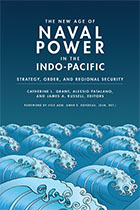
The New Age of Naval Power in the Indo-Pacific; Strategy, Order and Regional Security. Catherine L Grant, Alessio Patalano and James A Russel, Editors. Georgetown University Press, Washington DC, 2023.
Reviewed by Tim Coyle
The New Age of Naval Power in the Indo-Pacific is the main concern of strategists and defence planners, as well as the title of this timely and important work. The People’s Republic of China (PRC) continues its relentless long-term campaign to expunge its perceived ‘century of shame’ (1840 to 1950) during which China was pillaged and subjugated by western powers and Japan. The Communist victory over the Kuomintang in 1950 saw the vanquished Nationals retreating to Taiwan and the PRC has continually voiced its determination to reabsorb it into greater China. Since approximately 2000, and accelerating from 2012 under Xi Jinping, the PRC has achieved world power status, particularly at sea.
That power is demonstrated via an escalatory three-stage maritime strategy to enforce PRC maritime territorial claims comprising the ‘nine-dash line’ (recently to ‘ten-dash’ to encompass Taiwan) through the East and South China Seas, and beyond into the western Pacific. The PRC maritime strategy harnesses an enormous ‘dual-purpose’ fishing fleet under the People’s Armed Police Maritime Militia to harass regional maritime entities, at a lower level, leading to an ‘intermediate’ stage of harassment via the China Coast Guard (the world’s largest), with the People’s Liberation Army – Navy, as the ultimate coercive enforcer.
This strategy, constructed at breakneck pace through Xi Jingping’s paramount leadership, has spurred Indo-Pacific regional states to scramble to counter this unprecedented application of sea power which any thoughtful observer should regard, albeit malevolent, as a wholly innovative interpretation of maritime strategic practice.
Ranged against PRC sea power is a conglomeration of alliances and partnerships: the Quad (the US, Japan, India and Australia), the Association of South East Asian Nations, AUKUS, and ANZUS, to name the more prominent. European countries, such as the UK, Germany and France (with its Pacific territories) have also actively joined as regional maritime partners.
The New Age of Naval Power in the Indo-Pacific seeks to provide a contemporary analysis of this return to great power naval competition. Its contributors comprise national security specialists from prestigious university faculties and strategic analysis institutes; Australian contributors are Richard Dunley and the late James Goldrick. The book’s setting is naval power as the framework for Indo-Pacific regional security. Freedom of navigation is challenged by qualitative increases in military power (largely by China but also demonstrated in other regional settings). This has reduced the traditional US regional superiority in maintaining the ‘rules-based order’ – a previously comforting concept which was hardly mentioned before the PRC began exercising its hegemonic aspirations. As a result, the US now looks to alliances and partnerships as a matter of primary importance. Some might interpret this as a reprise of US Chief of Naval Operations, Admiral Mike Mullen’s, 2006 concept of a ‘1000 ship navy’ in which he challenged the US Navy to devise a strategy for collaboration with the world’s navies, coast guards and maritime industries for the benefit of all users of the sea. This was during the halcyon post-Cold War strategic environment; however, circumstances have wholly changed through the PRC’s attainment of regional preponderance.
The book advances five factors of naval power influence: Sea Control/Power Projection, Law of the Sea, Strategic Deterrence, Resources and Exploitation, and Technological Edge. The PRC, the US and regional maritime forces are engaged in exploiting and defending these factors in ways analogous to their national interests which relate to statecraft.
The work comprises three Parts, the first of which discusses how the sea informs national strategies and how governments acquire maritime capabilities to pursue claims and exploit resources. In this consideration, nuclear deterrence order and stability is examined insofar as it adds complexity to the broader regional structural competitiveness as exercised by China, Russia, the US and North Korea.
The second Part reviews historical linkages with regional competition. These range from the trade competitions of the 19th century and the political outcomes through the 1920s and -30s leading to World War Two and the later advent of the United Nations Convention of the Law of the Sea.
Part three focuses on sub-regional aspects: Northeast Asia, the East and South China Seas, the Taiwan Strait, the South Pacific and the Indian Ocean. The contributors analyse specific naval power issues, expanding on the main themes of Part One. The territorial disputes between North and South Korea, Russia and Japan and South Korea and China are examined in the light of sub-regional tensions. Similarly, the East and South China Seas show how localised disputes affect broader aspects of international security. The late James Goldrick, in his discussion of the South Pacific, offers contrasting analysis to the larger themes of Sino-American competition by highlighting climate change effects in that region and its impact on maritime strategy. The discussion on the burgeoning US-India relationship questions whether India will reinforce the Quad through maritime support east of the Malacca Strait rather than maintaining its traditional focus on the Indian Ocean.
Taiwan occupies a particularly significant contribution to the book by examining the security dynamics and capabilities of both sides. However, these are not limited to the Taiwan Strait as they figure prominently in Taiwan’s situation as a prime factor in PRC and US strategies. From these factors changes in the cross-Strait military balance increase the risk of conflict. Here we can see the full range of deployed PRC capabilities – from attempting to convince the Taiwanese to accede to PRC demands without harming Taiwan’s economy and industry through graduated military power short of outright war.
The New Age of Naval Power in the Indo-Pacific is a most incisive and valuable study, defining maritime power as a control feature of regional security. The book’s contributors provide a comprehensive macro-overview with interlinked sub-regional analyses. It should attract a wide readership from international security specialists in government, defence, academia, and diplomatic communities.



